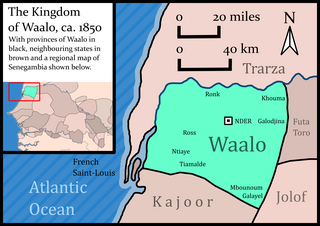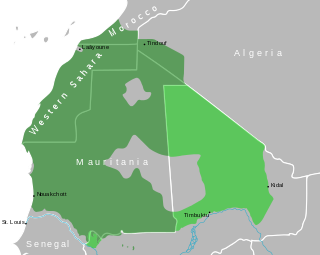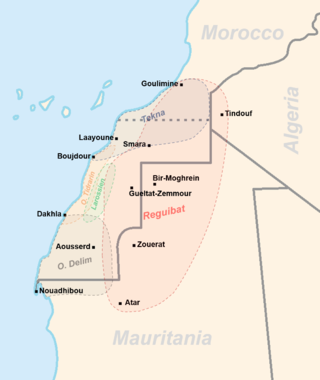Related Research Articles

The Almoravid dynasty was a Berber Muslim dynasty centered in the territory of present-day Morocco. It established an empire that stretched over the western Maghreb and Al-Andalus, starting in the 1050s and lasting until its fall to the Almohads in 1147.
The original inhabitants of Mauritania were the Bafour, presumably a Mande ethnic group, connected to the contemporary Arabized minor social group of Imraguen ("fishermen") on the Atlantic coast.
The history of Western Sahara can be traced back to the times of Carthaginian explorer Hanno the Navigator in the 5th century BC. Though few historical records are left from that period, Western Sahara's modern history has its roots linked to some nomadic groups such as the Sanhaja group, and the introduction of Islam and the Arabic language at the end of the 8th century AD.

Waalo was a kingdom on the lower Senegal River in West Africa, in what is now Senegal and Mauritania. It included parts of the valley proper and areas north and south, extending to the Atlantic Ocean. To the north were Moorish emirates; to the south was the kingdom of Cayor; to the east was Jolof.

Beni Ḥassan is a Bedouin Arab tribe which inhabits Western Sahara, Mauritania, Morocco and Algeria. It is one of the four sub-tribes of the Beni Maqil who emigrated in the 11th century from South Arabia to the Maghreb with the Bani Hilal and Banu Sulaym Arab tribes. In the 13th century, they took the Sanhaja territories in the southwest of the Sahara. In Morocco, they first settled, alongside their Maqil relatives, in the area between Tadla and the Moulouya River. The Sous Almohad governor called upon them for help against a rebellion in the Sous, and they resettled in and around that region. They later moved to Mauritania, and from the 16th century onwards, they managed to push back all black Mauritanians southwards to the Senegal Valley river. The Beni Hassan and other warrior Arab tribes dominated the Sanhaja Berber tribes of the area after the Char Bouba war of the 17th century. As a result, Arabs became the dominant ethnic group in Western Sahara and Mauretania. The Bani Hassan dialect of Arabic became used in the region and is still spoken, in the form of Hassaniya Arabic. The hierarchy established by the Beni Hassan tribe gave Mauritania much of its sociological character. That ideology has led to oppression, discrimination and even enslavement of other groups in Mauritania.

The Sahrawis, or Sahrawi people, are an ethnic group native to the western part of the Sahara desert, which includes the Western Sahara, southern Morocco, much of Mauritania, and along the southwestern border of Algeria. They are of mixed Hassani Arab and Sanhaji Berber descent, as well as West African and other indigenous populations.

Abu Bakr ibn Umar ibn Ibrahim ibn Turgut, sometimes suffixed al-Sanhaji or al-Lamtuni was a chieftain of the Lamtuna Berber Tribe and Amir of the Almoravids from 1056 until his death. He is credited to have founded the Moroccan city of Marrakesh, and under his rule the heretic Barghawatas were destroyed. In 1076, he conquered Koumbi Saleh capital of the Ghana Empire, and is credited to have brought Islam in this Western Sub-Saharan Africa region. In November of 1087, Abu Bakr died of a poisoned arrow in what is now Mauritania.

The Sanhaja were once one of the largest Berber tribal confederations, along with the Zanata and Masmuda confederations. Many tribes in Algeria, Libya, Mali, Mauritania, Morocco, Niger, Senegal, Tunisia and Western Sahara bore and still carry this ethnonym, especially in its Berber form.
Abdallah ibn Yasin was a theologian, spiritual leader and the founder of the Almoravid movement.
The Lamtuna are a nomadic Berber tribe belonging to the Iẓnagen / Sanhaja (Zenaga) confederation, who traditionally inhabited areas from Sous to Adrar Plateau. During the Almoravid period, many Lamtunas emigrated northwards. Currently, the Lemtuna Tribe is based in the South of Mauritania. The chief of this Tribe is Mr. Limam Ould Teguedi Among notable families are the family of Ehl Aly Ibn Ibrahim, the family of Ehel Sidelemine, Ehl Abdawa, Ehl Mohamed El-Emine and Ehl Mohammed Ghali. Sahrawi Tajakant as well as Messouma tribes are of the most recognisable offshoots of the Lamtunas. They inhabit the area between Morocco and Western Sahara. The Banu Ghaniya, the successors of this dynasty in Tripoli and the Nafusa Mountains and the governors of the Spanish Balearic Islands until about the middle of the 13th century, originated from this tribe as well.
The Tajakant is a Sahrawi tribe of Berber Sanhaja origins. They speak Hassaniya Arabic.
The Char Bouba war, also known as the Mauritanian Thirty Years' War or the Marabout War, took place between 1644 and 1677 in the tribal areas of what is today Mauritania and Western Sahara as well as in the Senegal river valley. It was fought between the Sanhadja Berber tribes and Muslim populations in the river valley, led by Lamtuna Imam Nasr ad-Din, on one hand; and the Maqil Arab immigrant tribes, foremost of which was the Beni Hassan, as well as the traditional aristocracies of the Wolof states on the other, supported by the French.

The Emirate of Trarza was a precolonial state in what is today southwest Mauritania. It has survived as a traditional confederation of semi-nomadic people to the present day. Its name is shared with the modern Region of Trarza. The population, a mixture of Berber tribes, had been there for a long time before being conquered in the 11th century by Hassaniya Arabic speakers from the north. Europeans later called these people Moors/Maures, and thus have titled this group "the Trarza Moors".

The medieval era of Tunisia began with what would eventually return Ifriqiya to local Berber rule. The Shia Islamic Fatimid Caliphate departed to their newly conquered territories in Egypt leaving the Zirid dynasty to govern in their stead. The Zirids would eventually break all ties to the Fatimids and formally embrace Sunni Islamic doctrines.

Precolonial Mauritania, lying next to the Atlantic coast at the western edge of the Sahara Desert, received and assimilated into its complex society many waves of Saharan migrants and conquerors.
Abu Zakariyya Yahya ibn Umar ibn Talagagin ibn Turgut ibn Wartasin, commonly suffixed al-Lamtunial-Sanhaji, was a chieftain of the Lamtuna, a tribe in the Sanhaja confederation. Yahya ibn Umar was the second emir of the Almoravids in the mid-11th century, a movement his predecessor, Yahya Ibn Ibrahim, constructed in collaboration with the religious leader Abdallah ibn Yasin. Yahya led the Almoravid armies in their first campaigns, including captures of Sijilmassa and Awdaghost in 1054/55, but was himself killed in battle against a dissident Berber faction in the Adrar. Yahya was succeeded as Almoravid emir by his brother, Abu Bakr ibn Umar.

The people of Mauritania are overwhelmingly adherents of Sunni Islam, of the Maliki school of jurisprudence.
The Zawaya are tribes in the southern Sahara who have traditionally followed a deeply religious way of life. They accepted a subordinate position to the warrior tribes, whether Arab or Berber, who had little interest in Islam. The Zawaya introduced Sufi brotherhoods to the black populations south of the Sahara. The jihad movements of the Fula people in the eighteenth and nineteenth centuries have their origins with the Zawaya. Today the Zawaya are one of the two noble castes of Mauritania.
The Torodbe; singular Torodo were Muslim Toucouleur clerics and theocratic monarchs who preached and reigned in Futa Toro, a region located in the north of present-day Senegal, and other Fula communities in West Africa from at least the seventeenth to the early twentieth century. Drawn from all ethnicites and levels of society, the Torodbe aimed to 'purify' the Islam practiced in West Africa and establish Islamic states run with Islamic law.
The Battle of Tabfarilla was a military conflict between the Lamtuna and the Godala. Both of them Muslim Berber Sanhaja tribes of the Sahara Desert and one time allies, the Lamtuna formed the core of the Almoravids after the Godala broke away. The Almoravid Emir Yahya ibn Umar al-Lamtuni was sent against the Godala.
References
- ↑ Thomas, Douglas H. (2021). "The Lingeer's Jihad: Challenging a Male-Normative Reading of African History" (PDF). History in Africa. 48: 326. doi:10.1017/hia.2021.10. S2CID 246702643 . Retrieved 27 October 2023.
- Douglas Thomas; Temilola Alanamu (31 December 2018). African Religions: Beliefs and Practices through History. ABC-CLIO. p. 182. ISBN 978-1-61069-752-1.